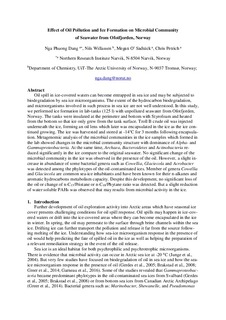| dc.contributor.author | Dang, Nga Phuong | |
| dc.contributor.author | Willassen, Nils Peder | |
| dc.contributor.author | O'Sadnick, Megan Eileen | |
| dc.contributor.author | Petrich, Christian | |
| dc.date.accessioned | 2020-02-07T10:07:56Z | |
| dc.date.available | 2020-02-07T10:07:56Z | |
| dc.date.created | 2018-10-30T13:27:14Z | |
| dc.date.issued | 2018 | |
| dc.identifier.isbn | 978-0-660-04851-2 | |
| dc.identifier.uri | http://hdl.handle.net/11250/2640270 | |
| dc.description.abstract | Oil spill in ice-covered waters can become entrapped in sea ice and may be subjected to biodegradation by sea ice microorganisms. The extent of the hydrocarbon biodegradation, and microorganisms involved in such process in sea ice are not well understood. In this study, we performed ice formation in lab-tanks (125 l) with unpolluted seawater from Ofotfjorden, Norway. The tanks were insulated at the perimeter and bottom with Styrofoam and heated from the bottom so that ice only grew from the tank surface. Troll B crude oil was injected underneath the ice, forming an oil lens which later was encapsulated in the ice as the ice con-tinued growing. The ice was harvested and stored at -14°C for 3 months following encapsula-tion. Metagenomic analysis of the microbial communities in the ice samples which formed in the lab showed changes in the microbial community structure with dominance of Alpha- and Gammaproteobacteria. At the same time, Archaea, Bacteroidetes and Actinobacteria reduced significantly in the ice compare to the original seawater. No significant change of the microbi-al community in the ice was observed in the presence of the oil. However, a slight increase in abundance of some bacterial genera such as Cowellia, Glaciecola and Acrobacter was detect-ed among the phylotypes of the oil-contaminated ices. Member of genera Cowellia and Glaciecola are common sea-ice inhabitants and have been known for their n-alkanes and aro-matic hydrocarbons metabolism capacity. Despite this development, no significant loss of the oil or change of n-C17/Pristane or n-C18/Phytane ratio was detected. But a slight reduction of water soluble PAHs was observed that may results from microbial activity in the ice. | |
| dc.description.abstract | Effect of Oil Pollution and Ice Formation on Microbial Community of Seawater from Ofotfjorden, Norway | |
| dc.language.iso | eng | |
| dc.relation.ispartof | Proceedings of the Forty-first AMOP Technical Seminar, Environment and Climate Change Canada Ottawa, ON, Canada | |
| dc.subject | Sjøis | |
| dc.subject | Sea ice | |
| dc.subject | Crude oil | |
| dc.subject | Oljeforurensning | |
| dc.subject | Oil pollution | |
| dc.subject | Microorganism | |
| dc.title | Effect of Oil Pollution and Ice Formation on Microbial Community of Seawater from Ofotfjorden, Norway | |
| dc.type | Chapter | |
| dc.description.version | acceptedVersion | |
| dc.subject.nsi | VDP::Matematikk og naturvitenskap: 400 | |
| dc.subject.nsi | VDP::Mathematics and natural scienses: 400 | |
| dc.source.pagenumber | 546-558 | |
| dc.identifier.cristin | 1624935 | |
| dc.relation.project | Nordland fylkeskommune: 186/2015 | |
| cristin.unitcode | 6228,0,0,0 | |
| cristin.unitname | Norut Northern Research Institute Narvik AS | |
| cristin.ispublished | true | |
| cristin.fulltext | postprint | |
